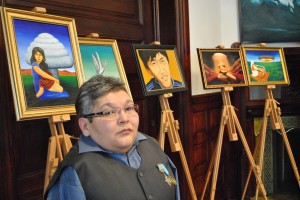This opinion was first published by Al Jazeera on Aug. 28.
The UN International Day against Nuclear Tests on August 29 is an opportunity to remind the world about the inhumane consequences of nuclear explosions. It is a day which has a special meaning for the many thousands of people who, like me, grew up in Eastern Kazakhstan.
 I was born 100 kilometres from the Semipalatinsk nuclear test site where the Soviet Union exploded more than 600 nuclear devices between 1949 and 1991. They have had terrible physical consequences for the people who lived near them.
I was born 100 kilometres from the Semipalatinsk nuclear test site where the Soviet Union exploded more than 600 nuclear devices between 1949 and 1991. They have had terrible physical consequences for the people who lived near them.
I came into this world without arms. People often ask me if I can be sure that radiation was the cause. If you had lived in my home town or region, this would not be a question.
In the place where I grew up, I saw mothers and midwives shocked at the sight of their babies. I saw families too embarrassed to show their children to the outside world, hiding them deep inside their homes and bringing them out only briefly for fresh air and sun.
I witnessed families and whole communities decimated by radiation-related cancers. As the United Nations confirms, more than 1.5 million people in Kazakhstan have suffered the effects of Soviet nuclear weapons testing.
The most terrifying fact about this story is that we didn’t understand the impact these explosions would have. We were taken completely by surprise – and this, I believe, is why it is so important that we use August 29 to warn the world about the impact of nuclear testing. We must never forget what happened or allow others to remain in the dark.
I saw so much tragedy and suffering in my homeland that I decided to do everything possible to ensure that my generation is the last to suffer such damage. I became an activist in an anti-nuclear weapons movement and found peace in expressing my pain through art.
I use my feet and mouth to hold my brush and pour out in my own colours my inner world, calling on others to follow my cause. Today, I am an honorary ambassador of The ATOM Project, an online campaign to encourage the global leadership needed to totally eliminate the nuclear threat.
Since its launch two years ago, The ATOM Project has taken the stories of Kazakhstan’s nuclear testing survivors around the globe. On my travels, I have made many new friends in many countries who have encouraged us to continue our work.
We now have over 90,000 supporters from more than 100 countries and have set ourselves a goal of reach the 100,000 mark by August 29. You can help us reach this milestone by signing the petition and showing your desire for a nuclear-weapons-free world.
And over the last two decades we have seen progress. Even before Kazakhstan became a fully independent country, our leader, and now President, Nursultan Nazarbayev shut down the Semipalatinsk test site in 1991 in defiance of [the] then Soviet government in Moscow. On independence, our country also voluntarily gave up the world’s fourth largest nuclear arsenal, which we had inherited from the Soviet Union. Similar courageous decisions were taken by Ukraine, Belarus and South Africa who all renounced their nuclear weapons or nuclear weapons programmes.
In 1996, a major step was taken when the Comprehensive Nuclear Test Ban Treaty was adopted by the United Nations. It has since been signed by 183 countries and ratified by 162. But the treaty cannot enter into force until it is signed and ratified by eight more countries: China, Egypt, India, Iran, Israel, North Korea, Pakistan and the United States.
It is to the leaders and lawmakers of these eight countries that I and my fellow nuclear testing survivors address our plea for understanding and leadership. Sign and ratify the Comprehensive Nuclear Test Ban Treaty. Help ensure that not one more person suffers from the consequences of nuclear testing and nuclear weapons use in the future.
I joined The ATOM Project because it inspired me to complete the mission I began decades ago. It may be that finally achieving the goal of eradicating the planet’s entire nuclear arsenal will have to be left to future generations. My vision is to make sure that every single person around me knows what was concealed for decades – the consequences of testing nuclear weapons.
Twenty years ago when I was in the United States, I met a Shoshone Indian chief. When he saw me, he fell to his knees, tears welling in his eyes, and whispered something down into the ground. A translator explained to me that the chief was begging for forgiveness from the Earth. He later urged me and my friends to continue to warn the rest of the world about the dangers of so profoundly defiling the planet.
That is my mission. I don’t have arms. I can’t know what it feels like to grasp someone by the hand. But I do have feet with which I can paint and I have a voice that enables me to speak.
For as long as I can, I will use whatever I have to tell the world about the catastrophic damage nuclear weapons have done to the planet and all who share it.
The author is the Honorary Ambassador of The ATOM Project.


